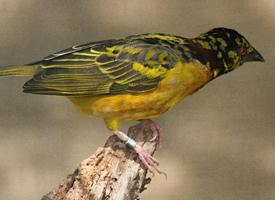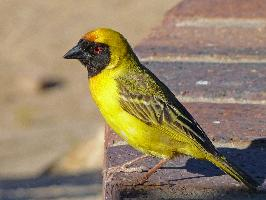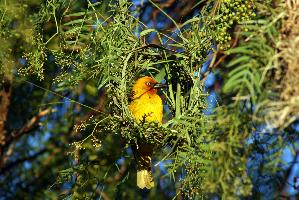
Známé také jako
- Snovač černohlavý
- Textor černohlavý
Váhy a míry
| Délka | od 15 do 17 cm |
|---|
Stav ohrožení
| Ohrožen |
Popis zvířete
The Village Weaver, scientifically known as Ploceus cucullatus, is a fascinating species of bird that belongs to the weaver family, Ploceidae. Renowned for their remarkable nest-building skills and vibrant plumage, these birds are a spectacle of nature's ingenuity and beauty.Adult male Village Weavers in their breeding plumage are particularly striking, with their deep yellow bodies contrasted sharply by a black face and throat. The crown often exhibits a variable amount of black, and the eyes are typically red, adding a vivid splash of color to their appearance. Outside the breeding season, males, females, and juveniles share a more subdued coloration, predominantly olive-green above and yellowish below, which provides them with excellent camouflage among the foliage.
Measuring approximately 15-17 cm in length and weighing around 35-45 grams, Village Weavers are relatively small but robust birds. Their strong, conical beaks are perfectly adapted for their granivorous diet, which predominantly consists of seeds, though they also consume insects, especially during the breeding season to provide protein-rich food to their chicks.
Village Weavers are gregarious and highly social birds, often found in large colonies. They exhibit a fascinating and highly complex breeding behavior. Males are polygynous, each mating with multiple females, and they engage in elaborate displays to attract mates, which include fluffing up their feathers, loud singing, and a variety of flight patterns.
One of the most remarkable aspects of the Village Weaver is its skill in nest construction. Males are the architects and builders of the nests, which are intricately woven from strips of grass or leaves. These nests are usually suspended from the tips of tree branches over water or in dense colonies on trees and bushes, providing protection from predators. The nests are kidney-shaped or spherical with a downward-facing entrance tunnel, showcasing the incredible craftsmanship of these avian builders.
The female lays between 2 to 4 eggs, which she incubates for about 14 days. The chicks are then fed by both parents and fledge approximately 17 days after hatching, though they may remain dependent on the parents for a few weeks thereafter.
Village Weavers are widely distributed across Sub-Saharan Africa, inhabiting a range of environments from open woodlands and grasslands to human-altered landscapes such as plantations, gardens, and agricultural fields. Their adaptability to different habitats and the availability of food sources have made them a common sight in many African regions.
Despite facing threats from habitat destruction and predation, Village Weavers are currently listed as Least Concern by the International Union for Conservation of Nature (IUCN), thanks to their wide range and large population. Nevertheless, their presence enriches the biodiversity of their ecosystems, serving as both pollinators and a source of natural pest control.
In summary, the Village Weaver is a remarkable bird species, celebrated for its striking appearance, complex social structures, and extraordinary nest-building abilities. These birds not only add vibrancy and dynamism to their habitats but also play significant roles in the ecological balance, highlighting the intricate connections within nature.
Podobná zvířata
Nové fotografie zvířat
Top 10 zvířat
- Chinese water dragon (Physignathus cocincinus)
- Galápagos tortoise (Geochelone nigra complex)
- Dolphin gull (Leucophaeus scoresbii)
- Japanese macaque (Macaca fuscata)
- Colombian red howler (Alouatta seniculus)
- Sea urchins (Echinoidea)
- Moustached guenon (Cercopithecus cephus)
- Diana monkey (Cercopithecus diana)
- Common reed warbler (Acrocephalus scirpaceus)
- Common house mosquito (Culex pipiens)

